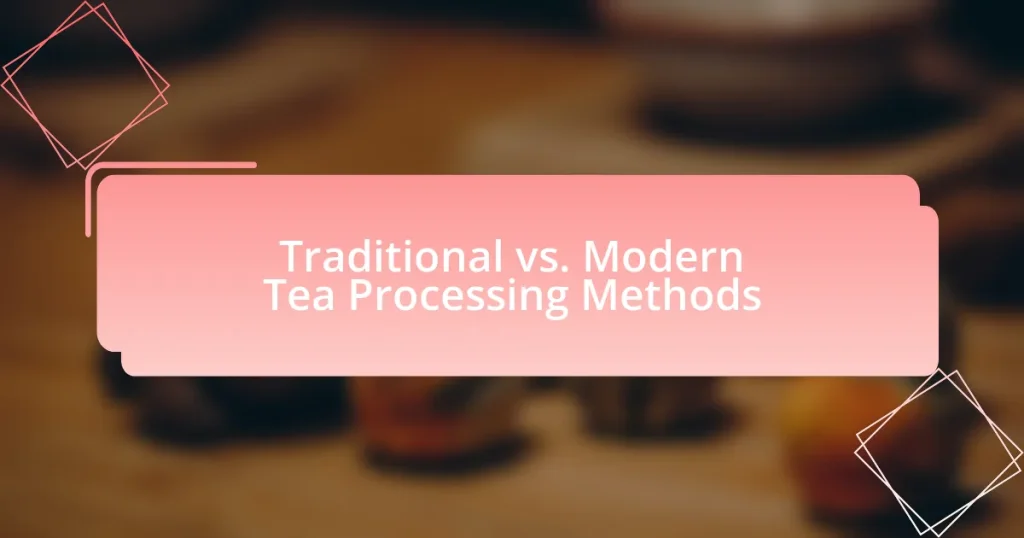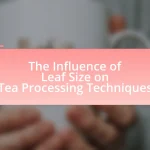The article examines the differences between traditional and modern tea processing methods, highlighting key techniques such as withering, rolling, oxidation, and drying. It details how traditional methods, characterized by manual labor and time-consuming processes, enhance flavor and aroma, while modern techniques leverage technology for efficiency and consistency. The impact of climate and geography on processing methods is discussed, along with the cultural significance of traditional practices. Additionally, the article compares the environmental sustainability of both methods and provides guidance for consumers on selecting high-quality tea based on processing techniques.
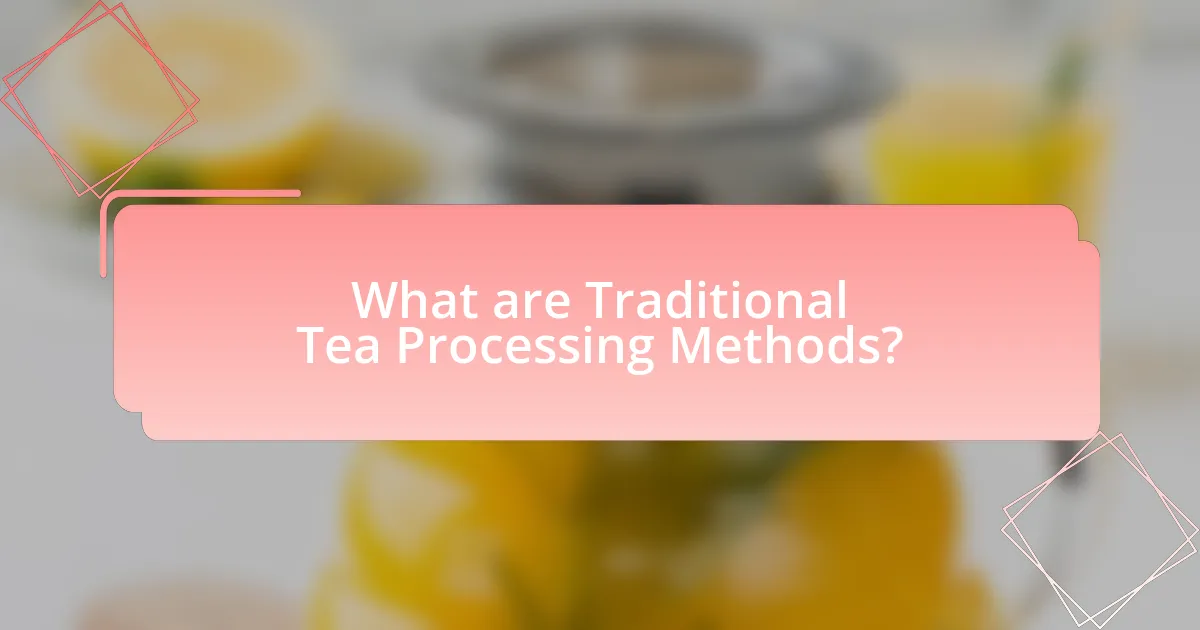
What are Traditional Tea Processing Methods?
Traditional tea processing methods include withering, rolling, oxidation, and drying. These methods are essential for developing the flavor and characteristics of different tea types. For instance, withering involves laying fresh tea leaves out to reduce moisture content, which is crucial for subsequent oxidation. Rolling shapes the leaves and initiates the oxidation process, which is vital for black and oolong teas. Oxidation, where leaves are exposed to air, enhances flavor and color, particularly in black tea. Finally, drying halts oxidation and preserves the tea. Historical practices, such as those in China and India, have established these methods, ensuring the unique qualities of various tea types are maintained.
How do Traditional Methods differ from Modern Techniques?
Traditional methods of tea processing typically involve manual labor and time-consuming techniques, while modern techniques utilize mechanization and technology to enhance efficiency and consistency. For instance, traditional methods may include hand-plucking leaves and sun-drying, which can take several hours or days, whereas modern techniques often employ machines for plucking and drying, significantly reducing processing time. Research indicates that modern methods can increase production capacity by up to 300%, allowing for larger quantities of tea to be processed in a shorter timeframe.
What are the key steps involved in Traditional Tea Processing?
The key steps involved in traditional tea processing are withering, rolling, oxidation, and drying. During withering, freshly plucked tea leaves lose moisture, which softens them for further processing. Rolling follows, where leaves are twisted and bruised to release essential oils and initiate oxidation. Oxidation is a crucial step that develops the tea’s flavor and color; it occurs when the rolled leaves are exposed to air. Finally, drying halts the oxidation process and preserves the tea, ensuring it is shelf-stable. Each of these steps is essential for producing high-quality traditional tea, as they influence the final taste and aroma.
How do climate and geography influence Traditional Methods?
Climate and geography significantly influence traditional tea processing methods by determining the types of tea that can be cultivated and the techniques used in their production. For instance, regions with high humidity and specific temperature ranges, such as those found in Assam, India, are ideal for growing robust tea varieties, which in turn dictate traditional methods like hand plucking and sun drying. Additionally, geographical features such as altitude affect the flavor profile of the tea leaves, leading to unique processing techniques that enhance these characteristics, as seen in high-altitude Darjeeling teas. Historical data shows that these environmental factors have shaped local practices over centuries, resulting in distinct traditional methods tailored to the specific climate and geography of each tea-growing region.
What are the benefits of Traditional Tea Processing?
Traditional tea processing offers several benefits, including enhanced flavor, improved aroma, and greater health benefits. The meticulous methods used in traditional processing, such as hand-picking and natural fermentation, preserve the tea’s essential oils and antioxidants, which contribute to its rich taste and aroma. Studies have shown that traditional processing methods can retain higher levels of catechins and polyphenols, compounds known for their health-promoting properties, compared to modern methods that may involve mechanical processing and additives. This preservation of natural compounds not only enhances the sensory experience but also provides potential health benefits, such as improved cardiovascular health and reduced inflammation.
How does Traditional Processing affect flavor and aroma?
Traditional processing significantly enhances the flavor and aroma of tea by utilizing methods such as withering, rolling, oxidation, and drying. These techniques allow for the development of complex chemical compounds, including polyphenols and essential oils, which contribute to the tea’s unique sensory profile. For instance, the oxidation process in black tea production leads to the formation of rich, malty flavors and aromatic compounds, while the minimal oxidation in green tea preserves fresh, grassy notes. Studies have shown that traditional methods can result in higher concentrations of flavor-active compounds compared to modern processing techniques, thereby enriching the overall tasting experience.
What cultural significance do Traditional Methods hold?
Traditional methods hold significant cultural importance as they embody the heritage, identity, and practices of communities engaged in tea production. These methods often reflect centuries-old techniques passed down through generations, preserving unique flavors and characteristics of the tea that are integral to local customs and rituals. For instance, in regions like China and Japan, traditional tea processing methods are not only about producing tea but also about fostering social connections and cultural expressions, such as tea ceremonies that emphasize mindfulness and respect. The preservation of these methods contributes to the cultural landscape, ensuring that the knowledge and skills associated with them remain alive, thus reinforcing community bonds and cultural identity.
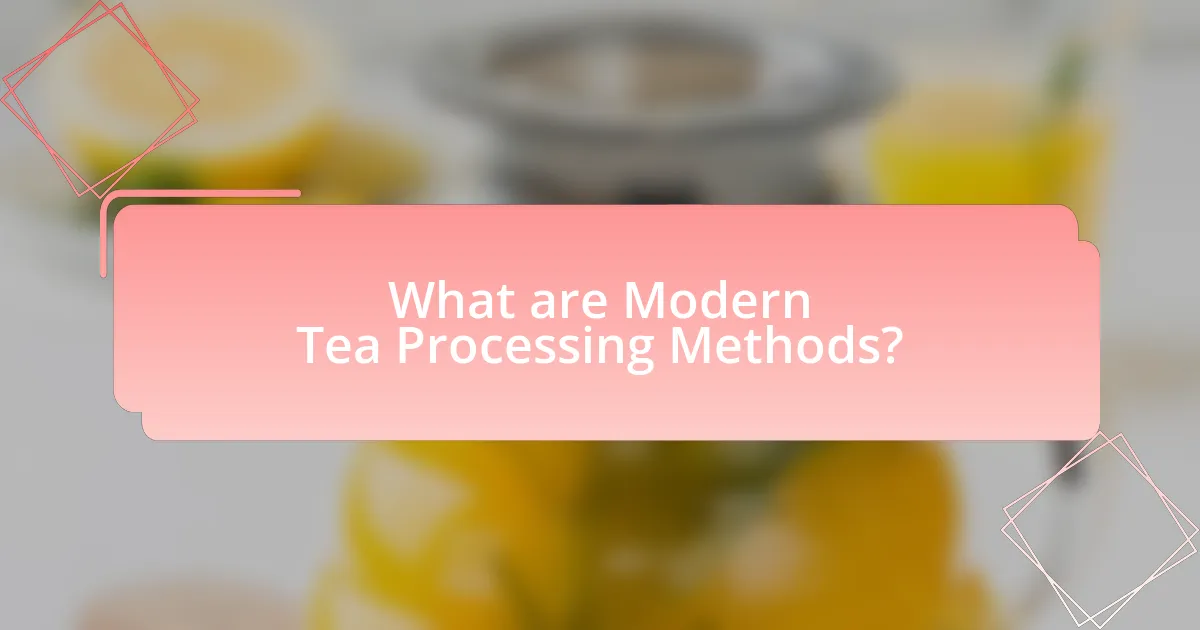
What are Modern Tea Processing Methods?
Modern tea processing methods include techniques such as withering, rolling, oxidation, and drying, which are designed to enhance flavor and preserve quality. Withering involves reducing moisture content in fresh tea leaves, allowing them to become pliable for rolling. Rolling shapes the leaves and initiates oxidation, a crucial step for developing flavor profiles, particularly in black and oolong teas. Oxidation is carefully controlled to achieve desired taste characteristics, while drying halts the oxidation process and preserves the tea. These methods have evolved with technology, incorporating machinery for efficiency and consistency, such as automated withering trays and temperature-controlled drying systems. The adoption of these modern techniques has been supported by research indicating that they can improve the overall quality and marketability of tea products.
How have Modern Techniques evolved over time?
Modern techniques in tea processing have evolved significantly from traditional methods, primarily through the integration of technology and scientific advancements. Initially, tea processing relied heavily on manual labor and artisanal practices, such as hand-plucking and sun-drying. Over time, innovations like mechanical harvesters, temperature-controlled drying machines, and automated fermentation processes have streamlined production, increased efficiency, and improved consistency in flavor and quality. For instance, the introduction of infrared drying technology has reduced drying time while preserving essential oils and flavors, enhancing the overall quality of the tea. This evolution reflects a broader trend in the food industry, where modern techniques aim to balance traditional craftsmanship with technological efficiency.
What technological advancements have influenced Modern Processing?
Technological advancements that have influenced modern processing include automation, precision agriculture, and data analytics. Automation has streamlined various stages of tea processing, such as with the use of machines for plucking and sorting, which increases efficiency and reduces labor costs. Precision agriculture employs sensors and drones to monitor crop health and optimize resource use, leading to higher yields and better quality tea. Data analytics allows producers to analyze market trends and consumer preferences, enabling them to make informed decisions about production and marketing strategies. These advancements collectively enhance productivity and quality in modern tea processing.
How do Modern Methods impact the quality of tea?
Modern methods significantly enhance the quality of tea by optimizing processing techniques and improving flavor consistency. Advanced technologies such as precision fermentation, controlled oxidation, and automated drying processes allow for better control over the chemical reactions that influence taste and aroma. For instance, studies have shown that using controlled environments during oxidation can increase the concentration of desirable compounds like catechins and flavonoids, which are linked to health benefits and flavor profiles. Additionally, modern methods can reduce contamination risks and improve the overall safety of tea products, ensuring a higher quality end product for consumers.
What advantages do Modern Processing Methods offer?
Modern processing methods offer increased efficiency, enhanced flavor profiles, and improved quality control in tea production. These methods utilize advanced technology, such as automated machinery and precise temperature controls, which streamline the processing stages, reducing labor costs and time. For instance, studies have shown that modern techniques can preserve more antioxidants in tea, leading to better health benefits compared to traditional methods. Additionally, modern processing allows for consistent product quality, as manufacturers can monitor and adjust variables in real-time, ensuring that each batch meets specific standards.
How do Modern Techniques improve efficiency and scalability?
Modern techniques improve efficiency and scalability in tea processing by utilizing automation, data analytics, and advanced machinery. Automation reduces manual labor and speeds up production processes, allowing for higher output with consistent quality. Data analytics enables real-time monitoring and optimization of production parameters, leading to reduced waste and improved resource management. Advanced machinery, such as high-capacity dryers and automated sorting systems, enhances processing speed and accuracy, facilitating scalability to meet growing market demands. For instance, the implementation of automated systems in tea factories has been shown to increase production rates by up to 30%, demonstrating a clear link between modern techniques and enhanced operational efficiency.
What role does innovation play in Modern Tea Processing?
Innovation plays a crucial role in modern tea processing by enhancing efficiency, quality, and sustainability. Advanced technologies such as automated machinery and precision fermentation techniques have significantly reduced processing time and labor costs while improving the consistency of flavor and aroma in tea products. For instance, the use of machine learning algorithms in quality control allows producers to monitor and adjust processing parameters in real-time, ensuring optimal outcomes. Additionally, innovations in packaging, such as biodegradable materials, contribute to environmental sustainability, aligning with consumer preferences for eco-friendly products. These advancements demonstrate that innovation is integral to meeting market demands and improving the overall tea production process.
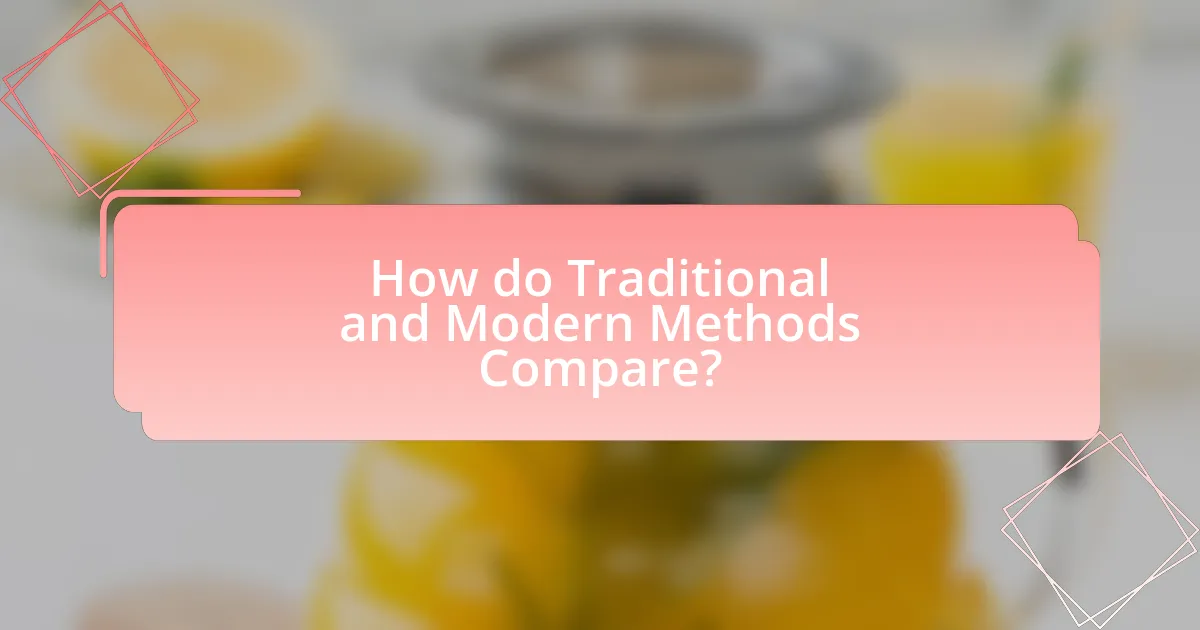
How do Traditional and Modern Methods Compare?
Traditional and modern tea processing methods differ significantly in techniques and outcomes. Traditional methods often involve manual labor, such as hand-picking leaves and using natural processes for withering, rolling, and drying, which can enhance flavor complexity and preserve the tea’s natural qualities. In contrast, modern methods utilize mechanization and technology, allowing for increased efficiency and consistency in production, often resulting in a more uniform product. For example, traditional Chinese green tea processing can take several hours, while modern methods can reduce this time to mere minutes through the use of machines. This shift has led to a broader availability of tea but may compromise some of the nuanced flavors found in traditionally processed teas.
What are the main differences in flavor profiles between the two methods?
The main differences in flavor profiles between traditional and modern tea processing methods lie in the complexity and intensity of flavors. Traditional methods, such as hand-rolling and sun-drying, often produce teas with nuanced, rich flavors that reflect the terroir and craftsmanship, resulting in a more aromatic and layered taste experience. In contrast, modern methods, which may involve mechanical processing and controlled environments, tend to yield teas with more uniform and sometimes less complex flavors, focusing on consistency and efficiency. For example, traditional Chinese green teas like Longjing exhibit a sweet, vegetal flavor due to careful hand processing, while modern green teas may lack this depth, emphasizing a more straightforward grassy taste.
How does processing time affect the final product in each method?
Processing time significantly influences the final product in both traditional and modern tea processing methods. In traditional methods, longer processing times often enhance flavor complexity and aroma, as seen in the slow oxidation of black tea, which can take several hours, allowing for deeper flavor development. Conversely, modern methods, such as those used in mass production, typically reduce processing time to increase efficiency, resulting in a more uniform but less nuanced flavor profile, as exemplified by the rapid steaming process used for green tea, which preserves freshness but limits depth. Thus, the duration of processing directly correlates with the sensory characteristics and quality of the tea produced.
What are the environmental impacts of Traditional vs. Modern Processing?
Traditional processing methods for tea typically have a lower carbon footprint and utilize fewer resources, as they often rely on manual labor and natural drying techniques. In contrast, modern processing methods tend to be more energy-intensive, employing machinery and technology that can lead to higher greenhouse gas emissions. For example, traditional methods may use sun-drying, which requires no electricity, while modern methods often involve electric dryers that consume significant energy. Additionally, traditional processing can promote biodiversity by maintaining local ecosystems, whereas modern methods may contribute to habitat destruction through industrial-scale farming practices.
Which method is more sustainable in the long term?
Traditional tea processing methods are more sustainable in the long term. These methods often utilize minimal energy, rely on natural resources, and maintain biodiversity by preserving local ecosystems. For instance, traditional practices such as hand-picking and sun-drying require less mechanization and reduce carbon emissions compared to modern methods that often involve energy-intensive machinery. Additionally, traditional methods promote soil health and reduce chemical inputs, leading to a more sustainable agricultural practice over time.
What practices can be adopted from both methods for better sustainability?
Practices that can be adopted from both traditional and modern tea processing methods for better sustainability include organic farming techniques and energy-efficient processing. Organic farming, utilized in traditional methods, reduces chemical inputs and enhances soil health, while modern methods often incorporate technology to optimize energy use during processing. For instance, traditional methods emphasize hand-picking and natural pest control, which can be combined with modern practices like solar drying and automated sorting to minimize waste and energy consumption. This integration leads to a more sustainable tea production system that maintains quality while reducing environmental impact.
What should consumers consider when choosing between Traditional and Modern Tea?
Consumers should consider the flavor profile, health benefits, and processing methods when choosing between Traditional and Modern Tea. Traditional Tea often emphasizes natural flavors and health benefits derived from minimal processing, such as hand-picking and sun-drying, which can enhance the tea’s antioxidant properties. In contrast, Modern Tea may incorporate innovative processing techniques, such as flavor infusions and rapid drying methods, which can alter the taste and potentially reduce some health benefits. Research indicates that traditional processing methods can retain higher levels of catechins, a type of antioxidant, compared to some modern methods. Therefore, understanding these differences can help consumers make informed choices based on their preferences for taste and health.
How can consumers identify the processing method used in their tea?
Consumers can identify the processing method used in their tea by examining the tea’s appearance, aroma, and flavor profile. For instance, green tea typically has a fresh, grassy aroma and a light green color due to minimal oxidation, while black tea is fully oxidized, resulting in a dark color and robust flavor. Additionally, consumers can look for specific labels or descriptions on packaging that indicate the processing method, such as “hand-rolled” or “pan-fired,” which provide insights into traditional methods. Research indicates that understanding these characteristics can help consumers make informed choices about the type of tea they prefer, as different processing methods significantly influence the final product’s sensory attributes.
What are the best practices for selecting high-quality tea based on processing methods?
To select high-quality tea based on processing methods, prioritize teas that undergo minimal processing, such as hand-picking and traditional methods like pan-firing or steaming. These methods preserve the natural flavors and health benefits of the tea leaves. For instance, green tea, which is often steamed or pan-fired, retains high levels of antioxidants compared to heavily processed black tea. Additionally, examine the appearance of the leaves; high-quality teas typically have whole, unbroken leaves, indicating careful handling. The aroma should be fresh and vibrant, reflecting the quality of the processing. Lastly, consider the source; reputable producers often adhere to traditional methods that enhance flavor and quality, as seen in regions like Uji in Japan for matcha or Darjeeling in India for black tea.
